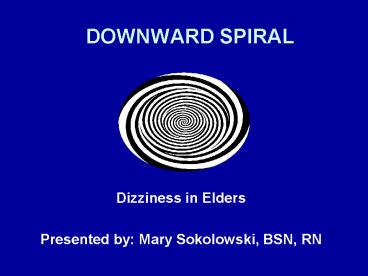DOWNWARD SPIRAL - PowerPoint PPT Presentation
Title:
DOWNWARD SPIRAL
Description:
DOWNWARD SPIRAL Dizziness in Elders Presented by: Mary Sokolowski, BSN, RN Introduction Definition of Dizziness: Various abnormal sensations Generic term ... – PowerPoint PPT presentation
Number of Views:130
Avg rating:3.0/5.0
Title: DOWNWARD SPIRAL
1
DOWNWARD SPIRAL
- Dizziness in Elders
- Presented by Mary Sokolowski, BSN, RN
2
Introduction
- Definition of Dizziness
- Various abnormal sensations
- Generic term giddiness, lightheadedness,
faintness, vertigo, ataxia - Syncope
- Loss of consciousness fall
3
SCOPE OF PROBLEM
- 90 million Americans seek care each year
- (Kovar, Jepson, Jones, 2006)
- Most common complaint gt age 75
- 1/3 to 1/4 of older adults c/o dizziness
- (Nettina, 2001)
- Syncope a main reason for inpatient care
- (Wohrle Kochs, 2003)
4
GERIATRIC SYNDROME?
- Nonspecific nature multiple causes
- Peripheral Vestibular 4 71
- Cerebrovascular 6 70
- Postural Hypotension 2 15
- Psychogenic 6 40
- (Kao, Nanda, Williams, Tinetti, 2001)
5
APPROACH
- Lack of clear guidelines
- Suggested approach
- Treat as syndrome
- Rule out treatable causes
- Assess risk factors for chronic dizziness
- (Salles, Kressig, Michel, 2003)
6
PATHOPHYSIOLOGY
- Several different body systems
- Disruption of stability affects balance
- Balance coordination of brain nerve impulses
from eyes, ears, neck, limbs, joints
7
REVIEW Vestibular System
- SEE HANDOUT
- Labyrinth
- 1) Cochlea (auditory receptors)
- 2) Vestibule, utricle, saccule
- 3) Semicircular canals
- Endolymph
- Hair cells
- Otoconia ear rocks
- (Hain Ramaswamy, 1999)
8
BALANCE
- Head movement ? hair cells bent by otoconia or
endolymph ? signal from inner ear ? 8th cranial
nerve ? cerebellum - Sensory system (eyes, muscles, joints) ? input to
brain - Brain interprets ? balance
- Distortion in any system
- Dizziness
9
HEIGHTS
10
MOTION SICKNESS
11
SPINNING
12
SUBTYPES / CATEGORIES
- Presyncope
- Vertigo
- Disequilibrium / Ataxia
- Psychogenic / Other
- (Nettina, 2001)
- SEE HANDOUT
13
Benign Paroxysmal Positional Vertigo
- 1 cause of vertigo
- Accounts for 50 of dizziness in elders
- Profile
- Abrupt dizziness with position changes
- /- nausea and vomiting
- Episodes lt 1 minute
- Accompanied by nystagmus
- (Kovar, et al., 2003)
14
BPPV Causes
- Otoconia in semicircular canals
- ½ - Idiopathic
- Other causes
- Head Injury
- Infection
- Degenerative changes of aging
- Migraines
- (Kovar et al. 2003)
15
SYNCOPE
- Definition
- A main reason for inpatient treatment
- Rapid onset with rapid recovery
- Episode lasts lt 20 seconds
- Misdiagnosis possible
- (Wohrle Kochs, 2003)
16
SYNCOPE Causes
- Cardiac disease, arrhythmia
- Reflex syndrome
- Orthostatic hypotension
- Carotid Sinus Syndrome
- Autonomic Failure
- (Wohrle Kochs, 2003)
17
DIAGNOSIS Dizziness
- 1st PRIORITY Recognize treatable conditions
- History
- Structured interview S/S, PMH
- Medication History
- DHI Scale see HANDOUT
- (Salles et al., 2003)
18
DIAGNOSIS Dizziness
- Physical Exam
- Broad Review of systems
- Rule out emergent conditions
- Vision, hearing, otoscopic exam
- Arthritis, neck pain, neuropathy
- (Wohrle Kochs, 2003)
19
DIAGNOSIS Dizziness
- Provocative Tests
- Orthostatic changes
- Hyperventilation
- Rapid head/neck movement
- Carotid sinus massage
- (Wohrle, 2003)
20
DIAGNOSIS Dizziness
- Provocative tests
- Vestibular testing
- Tilt testing
- Electrophysiology (EPS) studies
- Psychological testing
- Dix-Hallpike Maneuver HANDOUT
- (Kovar, et al., 2006)
21
DIAGNOSIS Dizziness
- 2nd Priority Assess Risk Factors for Chronic
Dizziness - 7 Risk factors
- Depressive S/S, cataracts, abnormal
balance/gait, postural BP changes, DM, past MI, gt
3 medications - Multifactoral syndrome
- (Kao et al. 2001)
22
Management/ Treatment
- Early Recognition of S/S KEY
- Treatment of etiologic factors
- Cardiac
- Sensory problems correction
- Vasovagal avoid triggers, salt, water, meds,
pacing - (Wohrle Kochs, 2003)
23
Management / Treatment
- Carotid sinus syndrome pacing, salt,
vasoconstriction - Orthostatic hypotension avoid meds, ETOH, large
meals caution with position changes - Cognitive behavioral therapy - ? anxiety
- (Wohrle Kochs, 2003)
24
Balance / Vestibular Rehab
- Repeated exposure to causative stimulus
- Epleys bedside maneuver
- Repositioning therapy
- Success rate
- DHI before and after
- (Kovar et al., 2006)
25
Antivertigenous Meds
- Meclizine / Antivert
- ? Labyrinth excitability
- Most effective motion sickness, vertigo
- Diphenidol nausea vertigo
26
PATIENT EDUCATION
- Minimize contributing factors
- Rise slowly, support stockings, avoid
- movements associated with vertigo
- Balance / Vestibular rehab
- Post V.R. sleep / head position
- recommendations
- Balance rehab muscle strengthening,
- Tai Chi
- Antivertigenous meds side effects, etc
27
SAFETY PLAN
- Environmental safety proofing home
- Driving discussion
- Emergency plan
28
CASE STUDY
- See HANDOUT
- (Nettina, 2001)
29
THE END
- ?? QUESTIONS ??






























